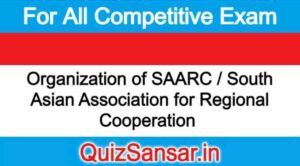
Organization of SAARC / South Asian Association for Regional Cooperation
The organization of SAARC is comprised of the Summit, SAARC Secretariat, and Council of Ministers, Standing Committee, Programming Committee and Technical Committees.
The summit is the highest policy making authority of the Association constituted by the heads of all the member countries. The summit called as the council meets almost every year in member countries on a rotational basis. If even one of the heads of member states cannot attend the meeting. it is not possible to hold the meeting of the council.
The SAARC Secretariat, co-ordinates and monitors the execution of the activities of SAARC, services the meetings and serves as the channel of communication between SAARC and other international organisations. It was set up at Kathmandu (Nepal) on January 16, 1987. The SAARC secretariat is headed by the Secretary-General, who is appointed by the Council of Ministers upon nomination by a member state on the principle of rotation in the alphabetical order for a fixed period of 3 years.
Apart from the Secretary General, the secretariat includes also eight Directors, one from each state and the general services staff. The directors are appointed by the Secretary General upon nomination by member states for a period of three years. The term of the directors can be extended, in special circumstances by another three years by The Secretary General, in consultation with the concerned member states.
Nepal bore the initial cost of the establishment of the Secretariat. The recurring expenditures on SAARC are shared among the member countries. India contributes 32 percent of the total expenditure followed by Pakistan that contributes 25 percent of it. Bangladesh, Nepal and Sri Lanka each accounts for 11 percent and Bhutan and Maldives each accounts for 5 percent of it.
There is also the Council of Ministers which is constituted by the Foreign Ministers of all the member states of SAARC. The council of ministers is entrusted with the responsibilities to formulate policies, to review progress. to decide on further areas of co-operation, to establish additional mechanisms as deemed necessary and to decide on other matters of general interest of the Association. The meeting of the Council of Ministers in held twice a year. It may have an extraordinary session, if all the members’ states agree to do so.
The SAARC organisaiton, in addition, includes a Standing Committee, a Programme Committee and Technical Committees. The Standing Committee is constituted by the foreign secretaries of the member states. Its responsibilities are to monitor and co-ordinate programmes, to work out modalities of their financing, to determine inter-sectoral priorities, and to mobilize regional and external co-operation. This committee normally meets twice a year and submits its report to the Council of Ministers.
The standing committee can institute action committees for the implementation of projects comprised of more than two member countries. All the member countries may not have the representation it.
In order to assist the standing committee, there is a Programme Committee comprised of senior officials. It is an adhoc body and meets prior to the sessions of the standing committee. It is entrusted with the tasks of the scrutiny of budget of the secretariat, to finalise the annual schedule of its activities, to deliberate upon any other matters assigned by the standing committee, to consider the reports of the technical Committees and SAARC Regional Centres and to submit its comments to e standing committee.
There are at present 12 Technical Committees related to agriculture, rural development, environment, health, population activities, transport, communications, science and technology, tourism etc. These committees include the representatives of all member states. They prepare programmes and projects in their respective areas.
They monitor and execute the activities in their fields and submit reports to the standing committee through the Programming Committee. There is rotation of chairmanship of every technical committee among the member countries in the alphabetical order every two years.






